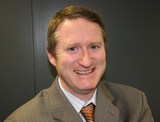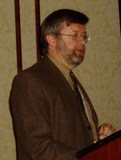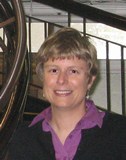SURREY FORUM STORY #2: Making Green Choices: Opportunities for Law and Policy to Effect Change on the Ground
Note to Reader:
To download a report-style, PDF version of the following web story, click on Making Green Choices: Opportunities for Law and Policy to Effect Change on the Ground.
1. Convening for Action in Metro Vancouver
How do we simultaneously work together as staff within a municipality and as a region AND externally with developers and other private sector players, to ensure we implement sustainable approaches to development?
The foregoing challenge provided context for advancing a ‘regional team approach’ at the Metro Vancouver Water Balance Model Forum on March 12, 2009. Hosted by the City of Surrey, this learning event is co-sponsored by the Water Balance Model Inter-Governmental Partnership and the Green Infrastructure Partnership.
Cross-Region Sharing:
 The Forum is part of the implementation program for Convening for Action in British Columbia, reports Ted van der Gulik, Chair of the Inter-Governmental Partnership. Collaboration, innovation, integration and partnerships are helping local governments in three regions (Metro Vancouver, the Okanagan and Vancouver Island) make the best choices for sustainable,
The Forum is part of the implementation program for Convening for Action in British Columbia, reports Ted van der Gulik, Chair of the Inter-Governmental Partnership. Collaboration, innovation, integration and partnerships are helping local governments in three regions (Metro Vancouver, the Okanagan and Vancouver Island) make the best choices for sustainable,  healthy and vibrant communities.
healthy and vibrant communities.
“Experience gained in one region can be adapted to suit the needs of the other regions, Cross-fertilization between regions creates the opportunity to continually build on the experience of others and take turns leapfrogging ahead.”
2. Forum Program – An Overview
The Forum program is built around the HOW question as it pertains to green infrastructure: HOW will the City of Surrey get it built right; HOW will a consistent regional approach be achieved in Metro Vancouver? The morning and afternoon parts of the program each comprise three modules.
Water Bucket Stories:
Previously, Story #1 in this series of Water Bucket articles introduced what will be covered in the morning and afternoon sessions. Now, this Story #2 elaborates on Module #5: Making Green Choices: Opportunities for Law and Policy to Effect Change on the Ground.
Module #5 is the bridge from the morning to the afternoon. The Forum focus is on legal and policy tools that will assist green infrastructure implementation.
Shared Responsibilities
“The Forum is designed to start a dialogue between policy-makers and project  implementers,” states Vincent Lalonde, the City’s General Manager, Engineering. “We are approaching the program design from a shared responsibility perspective; we will explore how policy and legal tools can help developers, regulators and designers collaborate to ensure responsible outcomes.”
implementers,” states Vincent Lalonde, the City’s General Manager, Engineering. “We are approaching the program design from a shared responsibility perspective; we will explore how policy and legal tools can help developers, regulators and designers collaborate to ensure responsible outcomes.”
 “The morning session will focus on the nuts-and-bolts of Surrey green infrastructure projects. The insights gained and lessons learned from Surrey’s implementation experience will inform what we do in the afternoon,” continues Ray Fung, Chair of the Green Infrastructure Partnership. “The morning and afternoon program content will be seamlessly integrated.
“The morning session will focus on the nuts-and-bolts of Surrey green infrastructure projects. The insights gained and lessons learned from Surrey’s implementation experience will inform what we do in the afternoon,” continues Ray Fung, Chair of the Green Infrastructure Partnership. “The morning and afternoon program content will be seamlessly integrated.
Making Green Choices:
“In particular, implementation issues raised in the morning session will be addressed in the afternoon module about Making Green Choices: Opportunities for Law and Policy to Effect Change on the Ground,” adds Ted van der Gulik. “This town hall sharing session will be led by Susan Rutherford, who represents West Coast Environmental Law on the Green Infrastructure Partnership Steering Committee.”
“Everyone will benefit from attending both the morning and afternoon sessions,” concludes Vincent Lalonde. “The policy people will have an appreciation for what is involved in constructing green infrastructure; and the implementers will understand what the provincial, regional and local goals are….and what we are trying to achieve through the use of policy and legal tools.”
3. Responsibility Framework
The Surrey Forum is a first step in advancing a regional team approach to rainwater management and green infrastructure that will align local actions with provincial goals as stated in Living Water Smart, BC’s Water Plan.
Creating Our Future
According to Kim Stephens, Forum team leader and Program Coordinator for the Water Sustainability Action Plan for British Columbia, “Living Water Smart  provides a framework and sets a direction. The purpose in convening for action is to establish consistent expectations on-the-ground: This is what we want to achieve, and this is how we will get there.”
provides a framework and sets a direction. The purpose in convening for action is to establish consistent expectations on-the-ground: This is what we want to achieve, and this is how we will get there.”
“Our immediate objective in convening for action is to encourage ‘green choices’ that will ripple through time, and will be cumulative in creating liveable communities and protecting stream health. We are NOT saying that every community must follow the same formula; what we are saying is that everyone needs to agree on expectations and how all the players….regulators, developers, designers, etc….will work together, and after that each community can reach its goals in its own way.”
What Tools Work?
“The Surrey Forum is an opportunity for Metro Vancouver participants to explore the responsibility theme,” states Susan Rutherford. “The program design for the Surrey Forum incorporates experience gained through successful team-building on Vancouver Island.”
“Each party in the process has a responsibility. So, we envision a discussion of the respective responsibilities involved in implementing a  vision, as well as a discussion of what your experience has to tell us about which tool – legal, policy or otherwise – is appropriate for holding each party accountable. In this way, we hope to learn what works well and what could work better.”
vision, as well as a discussion of what your experience has to tell us about which tool – legal, policy or otherwise – is appropriate for holding each party accountable. In this way, we hope to learn what works well and what could work better.”
“What tools work in which context? What are the legal tools and what are the challenges, and which legal tool makes the most sense for getting the job done?”
“What do you want to say to each other – the other parties in this joint endeavour of community development – about who has ‘dropped the ball’ in what process. What is (not) working?”
“Have you turned your mind to how this might work more effectively to achieve results? What bylaws, policies, procedures or other tools can you imagine would make this work better?”
Vancouver Island Pilot Region
Vancouver Island is the pilot region for a collaborative and inclusive approach to informing and educating local governments and the private sector.
“The Vancouver Island pilot has helped partner local governments conceptualize why a consistent approach to rainwater management and green infrastructure is needed and what it means regionally,” reports Kim Stephens. “Furthermore, the pilot program has provided the springboard for shared responsibility and bottom-up regional action to communicate, cooperate, collaborate and coordinate.”

 “The curriculum for the pilot program is based on a number of currently available guidance documents and/or tools, in particular Beyond the Guidebook: Context for Rainwater Management and Green Infrastructure in British Columbia.”
“The curriculum for the pilot program is based on a number of currently available guidance documents and/or tools, in particular Beyond the Guidebook: Context for Rainwater Management and Green Infrastructure in British Columbia.”
Beyond the Guidebook builds on the science-based foundation provided by Stormwater Planning: A Guidebook for British Columbia, published in 2002, and incorporates lessons learned over the past six years in moving from planning to action.
4. Opportunities for Law and Policy to Effect Change on the Ground
In Module #5 in the afternoon, Susan Rutherford will first introduce the Green Infrastructure Guide, published by West Coast in 2007. Then she will present the Commentary on Effective Municipal Rainwater/Stormwater Management in order toset the context for the town hall sharing session.
 “The Commentary is a 2-page synopsis that the Green Infrastructure Partnership prepared for Metro Vancouver; it is now being used provincially,” explains Susan Rutherford. “The Commentary identifies actions that can be taken at three scales – regional, local and private – to create liveable communities and protect stream health.”
“The Commentary is a 2-page synopsis that the Green Infrastructure Partnership prepared for Metro Vancouver; it is now being used provincially,” explains Susan Rutherford. “The Commentary identifies actions that can be taken at three scales – regional, local and private – to create liveable communities and protect stream health.”
In British Columbia, the Local Government Act vests the responsibility for drainage with municipalities, and British Columbia case law makes clear the responsibility of municipalities to manage runoff volume to prevent downstream impacts. An increasingly important corollary to that responsibility is the need to work from the regional down to the site scale, to maintain and advance watershed health to ensure that both water quantity and quality will be sustained to meet both ecosystem and human health needs.
Responsibility Matrix
“Looking ahead to March 12, we are in the process of framing a Responsibility Matrix that regulators, developers and designers will be able to use as a decision support tool,” states Susan Rutherford.
“For the first part of the matrix, think in terms of three columns: GOAL, PARTY and TOOL. Our focus is on the linkages – that is, how people interact and/or collaborate to achieve community development sustainability goals.”
“For the second part of the matrix, again think in terms of three columns that elaborate on the first part: RESPONSIBILITY, RESPONSIBLE PARTY and TOOL. Under responsibility, we will be defining a series of objectives and/or situations – for example, ensuring that the minimum topsoil requirement is achieved and maintained over time.”
Imagine….
“The Forum is an opportunity for people with different perspectives to talk candidly to each other about green infrastructure implementation. We want participants to feel comfortable to state what is on their minds,” continues Susan Rutherford.
 “If someone says something is not working, then the challenge for them is: Okay, what would make it work, and what are you going to do? “We see the Forum as providing an opportunity to generate some positive energy to overcome barriers. Our theme is ‘imagine’.”
“If someone says something is not working, then the challenge for them is: Okay, what would make it work, and what are you going to do? “We see the Forum as providing an opportunity to generate some positive energy to overcome barriers. Our theme is ‘imagine’.”
“What we have in mind when we say ‘imagine’ is that Forum participants would imagine a legal tool or procedure that would ensure that barriers are removed or other parties in the process more effectively fulfil their piece of the sustainable development puzzle.”
“Imagine what we could each do differently – for example, consider how the City of Courtenay imagined that things would be better if they could get their inspectors on-board with inspecting for topsoil and/or other green infrastructure features”.
“What we’d like the town hall sharing session to draw out is that there are solutions to be found, if the different parties /departments /local governments and regions simply talk to each other about how they could all work together more effectively, using law reform or other process changes as tools,” states Susan Rutherford in summary.
“Once we know what we want our watersheds and neighbourhoods to look like, the next step is to decide what the tools are that will get us there,” concludes Vincent Lalonde. “All of us ….whether we are regulators, developers or designers ….need to understand and care about the goal if we are to create the future that we all want.”
Performance Targets
Accompanying the Commentary on Effective Municipal Rainwater/Stromwater Management is a paper titled Beyond the  Guidebook: Establish Watershed-Specific Runoff Capture Performance Targets that was released at the 2008 Water Balance Model Partners Forum.
Guidebook: Establish Watershed-Specific Runoff Capture Performance Targets that was released at the 2008 Water Balance Model Partners Forum.
“The law and policy module will close by focusing our discussion of roles, responsibilities and tools on how performance targets for a region might be both arrived at, and achieved,” comments Susan Rutherford. “What are our respective roles and responsibilities for getting there? What tools can use to ensure that we are aligned and effective in the work that we do?”
Applying the Water Balance Model:
 “This introductory discussion will set the scene for Module #6,” adds Ted van der Gulik. “The module theme is Making Green Choices: Use the Water Balance Model to Inform Land Development Strategies.” On February 5, the Water Balance Model received a Premier’s Award for Innovation and Excellence.
“This introductory discussion will set the scene for Module #6,” adds Ted van der Gulik. “The module theme is Making Green Choices: Use the Water Balance Model to Inform Land Development Strategies.” On February 5, the Water Balance Model received a Premier’s Award for Innovation and Excellence.
“On the matter of the Living Water Smart initiative, I came away from our conversation with a strong conviction that the Premier means what he says, and says what he means about the province-wide importance of implementing BC’s Water Plan.”
5. What is a Regional Team Approach?
Vancouver Island is the pilot region for a precedent-setting approach to regional team-building. “Through programs such as the Vancouver Island Learning Lunch Seminar Series, we are informing and educating those who influence or impact how land is developed and water is used,” reports Kim Stephens.
Partnerships and Collaboration
“A regional team approach is founded on broad and inclusive partnerships and collaboration that reach for the common goal of sustainability. In short, we have set our sights on the common good and challenge the old barriers of jurisdictional interests. To achieve the common good, this requires bringing together:
- Local government – those who plan and regulate land use;
- Developers – those who build;
- The Province– those who provide the legislative framework;
- Universities and colleges– those who provide research; and
- The stewardship sector – those who advocate conservation of resources.”
“To get to the big picture, it starts with the smallest pieces. Hence, the Convening for Action team is advancing a regional team approach that aligns local actions with provincial policy goals, in particular those defined in the Living Water Smart guidance document,” concludes Kim Stephens.
Posted February 2009










